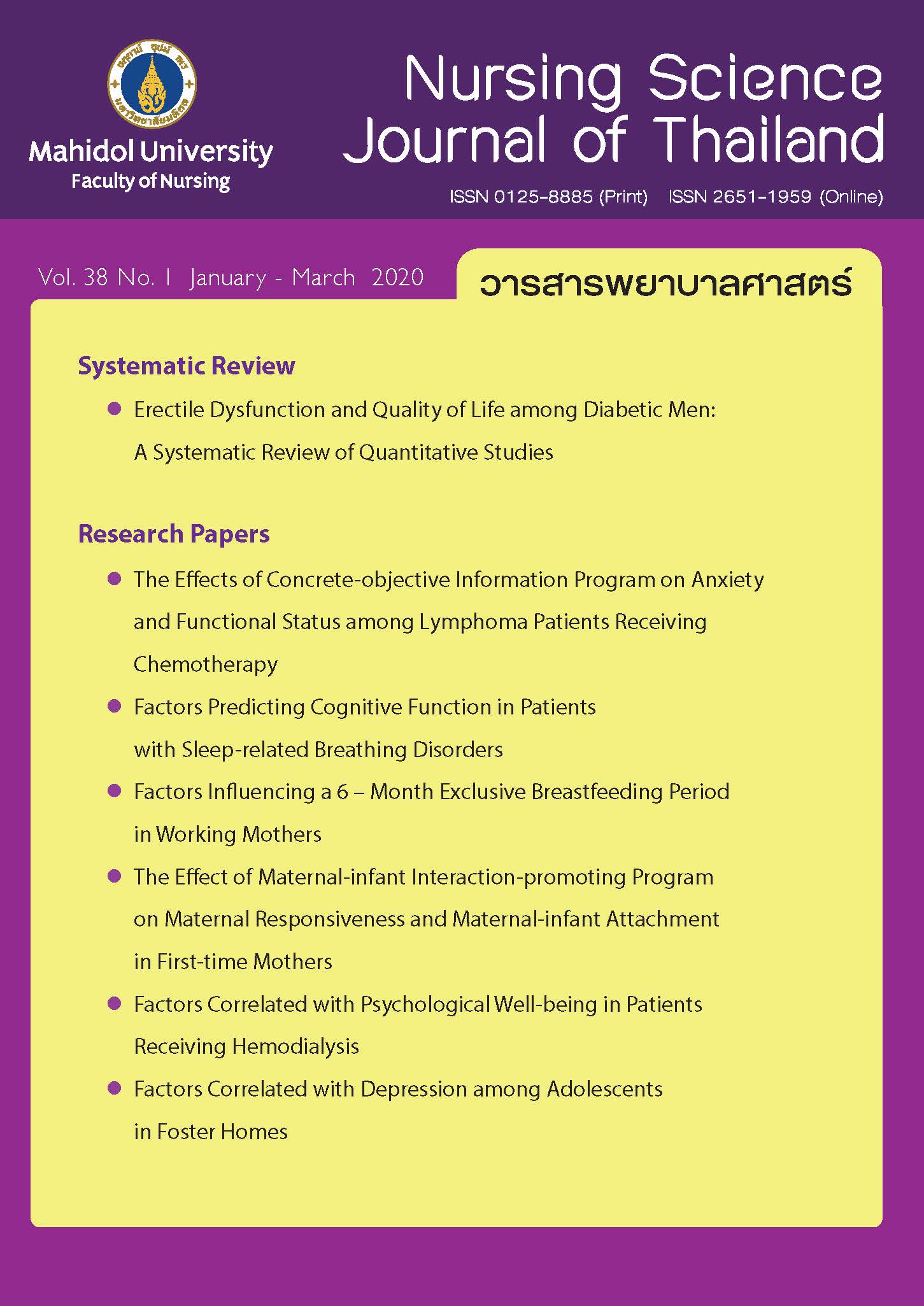The Effect of Maternal-infant Interaction-promoting Program on Maternal Responsiveness and Maternal-infant Attachment in First-time Mothers
Main Article Content
Abstract
Purpose: This research was designed to examine the effect of the maternal-infant interaction-promoting program on maternal responsiveness and maternal-infant attachment in first-time mothers.
Design: Quasi-experimental research, the posttest only control group design.
Methods: The sample was 51 dyads of healthy first-time mothers and their infants admitted to the postpartum unit at a university hospital in Bangkok. They were divided into the control and the experimental groups with 25 and 26 dyads in each group, respectively. The control group received only routine nursing care. The experimental group received routine nursing care and the maternal-infant interaction-promoting program. Data were collected by using the Personal Data Questionnaire, Maternal Infant Responsiveness Questionnaire, and Maternal Postnatal Attachment Questionnaire. Data were analyzed by descriptive statistics, independent t-test and Mann-Whitney U test.
Main findings: The study results revealed that mothers in the experimental group had a significantly higher mean score of maternal responsiveness and maternal-infant attachment than those in the control group (Z = -5.878, p < .05 and t = -6.116, p < .05, respectively) at one month postpartum.
Conclusion and recommendations: The maternal-infant interaction-promoting program during postpartum can enhance the mothers’ capability to understand infant cues. Therefore, they can be responsive to their infant’s behaviors, resulting in increasing maternal-infant attachment at one month postpartum. Therefore, nurses should be encouraged to use this program to teach new mothers about infant cues and how to response to their infant cues. Counseling should be provided to mothers who have a problem about reading the infant cues particularly during the first week after discharge from the hospital.
Article Details
Copyright Notice: Nursing Science Journal of Thailand has exclusive rights to publish and distribute the manuscript and all contents therein. Without the journal’s permission, the dissemination of the manuscript in another journal or online, and the reproduction of the manuscript for non-educational purpose are prohibited.

Disclaimer: The opinion expressed and figures provided in this journal, NSJT, are the sole responsibility of the authors. The editorial board bears no responsibility in this regard.
References
Shin H, Park YJ, Kim MJ. Predictors of maternal sensitivity during the early postpartum period. J Adv Nurs. 2006;55(4):425-34. doi: 10.1111/j.1365-2648.2006.03943.x.
Leigh P, Nievar MA, Nathans L. Maternal sensitivity and language in early childhood: a test of the transactional model. Percept Mot Skills. 2011;113(1):281-99. doi: 10.2466/10.17.21.28.PMS.113.4.281-299.
Shin H, Park YJ, Ryu H, Seomun GA. Maternal sensitivity: a concept analysis. J Adv Nurs. 2008;64(3):304-14. doi: 10.1111/j.1365-2648.2008.04814.x.
Klein PS, Rye H. Interaction-oriented early intervention in Ethiopia: the MISC approach. Infants Young Child. 2004;17(4):340-54. doi: 10.1097/00001163-200410000-00007.
Bigelow AE, MacLean K, Proctor J, Myatt T, Gillis R, Power M. Maternal sensitivity throughout infancy: continuity and relation to attachment security. Infant Behav Dev. 2010;33(1):50-60. doi: 10.1016/j.infbeh.2009.10.009.
Higley E, Dozier M. Nighttime maternal responsiveness and infant attachment at one year. Attach Hum Dev. 2009;11(4):347–63. doi: 10.1080/14616730903016979.
Choochaem C. Maternal self-efficacy regarding perceptions and responsiveness to newborn cues [master’s thesis]. Bangkok: Ramkhamhaeng University; 2009. 141 p. (in Thai).
Sumner G, Spietze A. NCAST Caregiving /parental-child interaction: teaching manual. Seattle: University of Washington; 1994. 156 p.
Bernard P, Gervais SJ, Allen J, Campomizzi S, Klein O. Integrating sexual objectification with object versus person recognition: the sexualized-body-inversion hypothesis. Psychol Sci. 2012;23(5):469-71. doi: 10.1177/0956797611434748.
Schafer R, Genna CW. Physiologic breastfeeding: a contemporary approach to breast feeding initiation. J Midwifery Womens Health. 2015;60(5):546-53. doi: 10.1111/jmwh.12319.
Klaus MH, Kennell JH. Maternal-infant bonding. 2nd ed. St. Louis, MO: Mosby; 1976. 260 p.
Ong SF, Chan WC, Shorey S, Chong YS, Klainin-Yobas P, He HG. Postnatal experiences and support needs of first-time mothers in Singapore: a descriptive qualitative study. Midwifery. 2014;30(6):772-8. doi: 10.1016/j.midw.2013.09.004.
Kurth E, Kennedy HP, Zemp Stutz E, Kesselring A, Fornaro I, Spichiger E. Responding to a crying infant - you do not learn it overnight: a phenomenological study. Midwifery. 2014;30(6):742-9. doi: 10.1016/j.midw.2013.06.017.
Chantarasena P. Primi para postpartum mother’s ability developments in responsiveness to the newborn’s cues. Khon Kaen: Khon Kaen University; 2008. 105 p. (in Thai).
Naowakhoaksorn T, Punthmatharith B, Naphapunsakul M. The effect of mother-infant interaction promoting program on maternal-infant attachment among adolescent mothers. Songklanagarind Journal of Nursing. 2015;35(2):143-60. (in Thai).
Glass GV. Primary, secondary, and meta-analysis of research. Educ Res. 1976;5(10):3-8. doi: 10.2307/1174772.
Phanthufak M, Phumonsakul S, Chareonpol O. The effect of a maternal role promoting program on maternal-infant attachment, maternal role satisfaction, competency in infant behavioral learning and infant growth. Ramathibodi Nursing Journal. 2009;15(2):149-61. (in Thai).
Cohen J. Statistical power analysis for the behavioral sciences. 2nd ed. New York: Lawrence Erlbaum; 1988. 559 p.
Barnard KE. Nursing child assessment and training: learning resource manual. Seattle, WA: University of Washington; 1978. 232 p.
Amankwaa LC, Younger J, Best A, Pickler R. Psychometric properties of the MIRI [unpublished manuscript]. Richmond, VA: Virginia Commonwealth University; 2002. 15 p.
Oncharoen G, Sinsuksai N, Phahuwatanakorn W, Limruangrong P. Factors influencing maternal responsiveness in first-time mothers. Journal of Nursing Science Chulalongkorn University. 2017;29(2):87-98. (in Thai).
Condon J, Corkindale C. The assessment of parent-to-infant attachment: development of a self-report questionnaire instrument. J Reprod Infant Psychol. 1998;16(1):57-76. doi: 10.1080/02646839808404558.
Condon J. Maternal postnatal attachment scale (measurement instrument) [Internet]. Adelaide: Flinders University; 2015 [cited 2018 Nov 15]. Available from: https://hdl.handle.net/2328/35291.
Songkram N. Design and multimedia development for learning. 1st ed. Bangkok: Chulalongkorn University Press; 2010. 163 p. (in Thai).
Pothichai P, Jenjaiwit P. Interaction promoting program for family with first-born infant. Journal of Nursing Science & Health. 2012;35(1):18-27. (in Thai).


